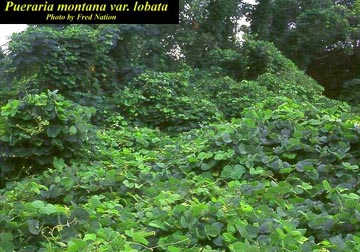Kudzu Pueraria montana
Kudzu is a perennial vine of the legume family. It has dark
green leaves, starchy fibrous roots, and elongated purple flowers
with a fragrance reminiscent of grapes readily identify this aggressive
vine. Kudzu leaves are hairy beneath, often tri-lobed, and in groups
of three on the vine. Kudzu fruits, present in October and November,
are hairy, bean-like pods which produce only a few viable seeds
in each pod cluster. During peak growing season in early summer,
this prolific vine can grow at a rate of a foot a day, easily covering
and choking trees and understory vegetation.
A native of Japan, kudzu was brought to the southeastern United
States at the turn of the century for use as a soil stabilizer,
animal food, and ornamental vine. Due to its prolific nature and
lack of natural insect or disease controls, kudzu quickly became
a pest. In 1970 it was listed as a common weed in the south by the
Soil Conservation Service. Today, kudzu is spread along the Atlantic
coast, north to Illinois and Massachusetts, west to Texas and Oklahoma,
and south to Alabama, Georgia and Mississippi where the heaviest
infestations occur. It has also recently been found in Florida where
it has begun to invade the Everglades.
|
|
 |
|
|


